Electric Current Waveform of the Injector as a Source of Diagnostic Information
Abstract
:1. Introduction
2. Laboratory Test Stand
3. Fuel Injection Phases
- phase 1—nozzle closed, core inductance equals ,
- phase 2—opening of the nozzle, change in core inductance from to ,
- phase 3—nozzle open, core inductance equals ,
- phase 4—closing of the nozzle: core inductance changes to ,
- phase 5—nozzle closed core inductance equals .
4. Analysis
4.1. Analysis of Changes in Voltage Waveforms
- location coefficient (),
- directional coefficient (), and
- influence of pressure ().
- Phase 0:Before the current impulse is started , the voltage in the injector coil equals the supply voltage:
- Phases 1, 2, 3, 4:After initiation of the current impulse, the voltage in the coil drops from the supply voltage value to zero:Such a state is maintained throughout the whole injection duration. This allows for the determination of the moment when the controller starts the process of fuel injection.
- Phase 5:After completion of the injection, as a result of releasing the energy compensated in the coil, there occurs an inductive voltage spike, exceeding the value of the source voltage . The inductive voltage spike results from the rapid decay of the current (Section 5,The high value of the current derivative (rapid decay to zero) multiplied by the coil inductance causes a generation of the voltage that may be a few times greater than the source voltage.
- Phase 6:After the voltage spike caused by the current decay, the voltage decays exponentially, going to zero, in accordance with the equation:The injector needle pushed by the force of the spring and by the force resulting from the fuel pressure , through the whole time of phase 6, shifts toward the nozzle, allowing the fuel flow. The motion of the needle being lifted due to the magnetic force is very quick. The needle returning from the coil core takes longer because the magnetic force is much greater than the force of the spring and of the force resulting from the fuel pressure:As a result of the gradual lowering, the needle rests against the nozzle, which stops the flow of fuel.
- Phase 7:At this point, the change in the core inductance finishes in accordance with the relationship: This is a transient state on the waveform of the voltage decay in the coil. The needle stoppage in the nozzle seat can be observed as a temporary flattening of the waveform of the decaying voltage:Observation of this range in real time, through control of the derivative of the voltage waveform , enables determination of the time of delay in closing the nozzle with the needle. The value of the voltage at which the needle settles in the nozzle determines the efficiency of the injector spring and determines the correctness of the mechanical system’s operation: the needle and the guide sleeve.
- Phase 8:After bringing the needle to a halt and stopping the fuel flow, the voltage decay takes place in accordance with inductance , going to zero, as shown in the Equation (11). Phase 8 is terminated at a point where the voltage in the coil equals zero: . Figure 5 shows a modeled voltage waveform of an injector in accordance with the presented equations (6–11). The waveform shown in a dotted green line is an actual waveform. The continuous line represents the modeled voltage waveform. In the table, in the top part of the figure, the successive ranges assigned to the current equations have been marked.
4.2. Analysis of Changes in Electric Current Waveforms
- Phase 1:At the point s (Figure 4), a current impulse starts determined by a given injection time. At this point, the value of current I = 0. The current increases exponentially, activating the magnetic flux due to which the magnetic force is generated. At phase , the magnetic force is smaller than the forces counteracting the lifting of the needle :The injector inductance is , and the time constant is . The nozzle is closed by the needle; thus, the flow does not occur. The duration of phase 1 is about 1 ms, and the equation describing the current is as follows:The way the current grows over time depends on the time constant τ. For example, the time constant for the coil in the R−L circuit amounts to (5). The value of the time constant can be read from the current plot for the value :A smaller value of the time constant means a faster increase in the electric current intensity The injector time constant (), determined on the basis of the resistance and coil inductance is an indicator that can be used while monitoring the electric efficiency of the coil. In the case of the injector, the time constant needs to be adopted as a specific value reached by the current after the voltage impulse has been turned on. It will determine the angle of the line denoting the increasing current intensity against the horizontal time axis The quantity from Equation (14) cannot be applied, because it is preceded by the transient state (needle lifting) and the time constant has an altered value. The best solution is adopting a defined characteristic of the inclination of the curve denoting the increasing current intensity (angle ), being a consequence of an injector’s qualities. Any change in the time constant ensues change in the increase in the current intensity at the range and . This parameter can be monitored by observing the derivative of the current intensity at this range: or changing the time range from driving the injection pulse to the point of raising the needle (waveform bends . Observation of the moment of occurrence of the whole transient state allows for evaluation of the magnetic force generated by the coil of the injector, i.e., the efficiency of its operation. Shifts in this range in time may indicate disturbances in the movement of the needle.
- Phase 2:At the point s (Figure 4), there occurs a flattening of the line denoting current intensity—the beginning of the transient state. This is a point at which the magnetic flux has already generated the magnetic force of the magnitude, which counterbalanced the forces in opposition to the lifting of the needle. Equation (13) is valid here. The duration of this range is approximately . The whole transient state lasts about (Figure 1—a black indicator, ). The beginning of the transient state on the current waveform is the current intensity at the point of the needle lifting . Changes in the value of the current intensity at this point indicate electrical changes in the injector coil. Shorted circuits in the coil cause a reduction in the generated magnetic flux, which in turn leads to an increase in the current. A greater current is needed for the generation of the magnetic flux, implying that the magnetic force is enough to overcome the resistance of the needle movement. Another cause for the change in the current is the changes in the fuel pressure before the injector (injection pressure). Differentiation between the discussed causes is possible based on the signal from the fuel pressure sensor.
- Phase 3:This phase takes place in the middle of the transient state. At , the magnetic force overcame the force . At this point, the process of the injector needle lifting starts. Sliding the needle into the core is synonymous with the change in the inductance of the injector coil (, Figure 4). The equation defining the current in this phase is as follows:where is the injector inductance after lifting the needle,The derivative of the waveform tends to zero, hence the denotation according to Equation (15). Due to the short time of this range, the decrease in the current is slight, but it can be observed as the flattening or bending of the line in the plot (Figure 4—black indicator (circle drawn with a dotted line)). In this phase, the fuel flow starts. In the transient state, there occurs a change in the injector core inductance, resulting from the summation of the masses of the core and the needle’s ferromagnetic material.
- Phase 4:The last phase of the transient state in the current-related waveform. The waveform of the current transitions from the decrease through the state in which the derivative of the waveform equals to zero to a rapid growth (Figure 4), which is in accordance with the equation:The final phase of the transient state overlaps with the beginning of the homogenous increase in current to the steady state (maximal for a given injection time). Two sections are combined here: the end of the transient state and an increase in the current intensity to its maximum. The maximal value at the preset duration of injection depends on the duration of this impulse. The value of the current intensity tends to quotient asymptotically in its exponential waveform. The needle is lifted, the injector coil core has an inductance equal to , and the fuel flow is continued. Resistance in the Euler’s number exponent is far greater than inductance ; e.g., the injector used in the experiment ratio to amounts to: . Therefore, the expression: has this effect in which the value of current tends to the defined value very fast.
- Phase 5:After the injection time is over, the electric current intensity rapidly decays to zero. Disconnecting the circuit means an increase in resistance to infinity, and the electromotive force increases its value (inductance peak) significantly above the level of the source voltage, which is a key factor in the speed of the current decay, and it takes place in accordance with the equation:This equation concludes the description of changes in the electric current at
5. Model—Supported Analysis of Injector Operation
- electric current value in the steady state (Figure 8; ),
6. Conclusions
Author Contributions
Funding
Conflicts of Interest
References
- Hung, N.B.; Lim, O.T. A simulation and experimental study on the operating characteristics of a solenoid gas injector. Adv. Mech. Eng. 2019, 11. [Google Scholar] [CrossRef] [Green Version]
- Leach, F.; Davy, M.H.; Henry, M.P.; Tombs, M.; Zhou, F. A New Method for Measuring Fuel Flow in an Individual Injection in Real Time. SAE Int. J. Engines 2018, 11, 687–696. [Google Scholar] [CrossRef]
- Czarnigowski, J. Experiments on the Effect of Pressure and Voltage Supply on Pulse Injector Opening Time. SAE Tech. Pap. 2014, 1, 9. [Google Scholar] [CrossRef]
- Mitukiewicz, G.; Burdzik, R.; Leyko, J. Relationship between LPG fuel and gasoline injection duration for gasoline direct injection engines. Fuel 2015, 153, 526–534. [Google Scholar] [CrossRef]
- Czarnigowski, J.; Jakliński, P.; Zyska, T. An empirical model of current in the pulse gas injector’s circuit. Prz. Elektrotechniczny 2014, 90, 195–198. [Google Scholar]
- Yao, X.; Zhang, Z.; Kong, X.; Yin, C. Dynamic Response Analysis and Structure Optimization of GDI Injector based on Mathematical Model. Int. J. Reliab. Qual. Saf. Eng. 2017, 25, 1850008. [Google Scholar] [CrossRef]
- Chai, B.; Gao, W. Simulation on fuel injection system for EUP based on AMESim. In Proceedings of the 2010 Second International Conference on Computer Modeling and Simulation, Sanya, China, 22–24 January 2010; Volume 3, pp. 456–458. [Google Scholar]
- Yan, F.; Zou, H.; Xiao, Q. Simulated Analysis on Dynamic Process of Electronic-controlled Injector. Available online: http://en.cnki.com.cn/Article_en/CJFDTotal-WHGY200412022.htm (accessed on 26 July 2020).
- Watanabe, H.; Ichise, S.; Nagaoka, T.; Tsuchiya, T. Development of Compact and High Performance Fuel Injector using Electromagnetic Field Simulation. Soc. Automot. Eng. Jpn. 2005, 32, 0019. [Google Scholar]
- Kay, P.J.; Bowen, P.; Gold, M.; Sapsford, S.M. Studies of gasoline direct—injesction sprays at elevated ambient gas temperatures and pressures. At. Sprays 2012, 22, 305–331. [Google Scholar] [CrossRef]
- Xue, G.; Zhang, P.; He, Z.; Li, D.; Yang, Z.; Zhao, Z. Displacement model and driving voltage optimization for a giant magnetostrictive actuator used on a high-pressure common-rail injector. Mater. Des. 2016, 95, 501–509. [Google Scholar] [CrossRef]
- Hung, N.B.; Lim, O.; Yoon, S. Effects of Structural Parameters on Operating Characteristics of a Solenoid Injector. Energy Procedia 2017, 105, 1771–1775. [Google Scholar] [CrossRef]
- Puškár, M.; Bigoš, P.; Kelemen, M.; Tonhajzer, R.; Šima, M. Measuring method for feedback provision during development of fuel map in hexadecimal format for high-speed racing engines. Measurement 2014, 50, 203–212. [Google Scholar] [CrossRef]
- Kusakabe, R.; Abe, M.; Ehara, H.; Ishikawa, T.; Mayuzumi, T.; Miyake, T. Injection Quantity Range Enhancement by Using Current Waveform Control Technique for DI Gasoline Injector. SAE Int. J. Engines 2014, 7, 560–567. [Google Scholar] [CrossRef]
- Cammalleri, M.; Pipitone, E.; Beccari, S.; Genchi, G. A mathematical model for the prediction of the injected mass diagram of a S.I. engine gas injector. J. Mech. Sci. Technol. 2013, 27, 3253–3265. [Google Scholar] [CrossRef]
- Mohapatra, C.; Jacobsohn, G.; Baldwin, E.; Schmidt, D. Modeling Sealing in Transient Injector Simulations. In Fluids Engineering Division Summer Meeting, Waikoloa, HI, USA, 30 July–3 August 2017; Paper No: FEDSM2017-69309, V01AT04A009; ASME: New York, NY, USA, 2017; p. 10. [Google Scholar]
- Yasukawa, Y.; Ishii, E.; Yoshimura, K.; Ogura, I.K. Fuel Spray Analysis Near Nozzle Outlet of Fuel Injector During Valve Movement. In Tagung Diesel- und Benzindirekteinspritzung 2016; Springer Vieweg: Wiesbaden, Germany, 2017; pp. 345–362. [Google Scholar]
- Shuai, G.; Baiyu, X.; Yunfen, H.; Hong, C. Injection quantity control for GDI engines. In Proceedings of the 25th Chinese Control and Decision Conference (CCDC); Guiyang, China, 25–27 May 2013; pp. 3593–3597. [Google Scholar]
- Marčič, S.; Marčič, M.; Praunseis, Z. Mathematical Model for the Injector of a Common Rail Fuel-Injection System. Engineering 2015, 7, 307–321. [Google Scholar] [CrossRef] [Green Version]
- Liu, Q.F.; Wang, C.Y.; Hu, Y.F.; Chen, H. Flatness-based Feedforward and Feedback Control for Fuel Rail System of Gasoline Direct Injection Engine. IFAC Pap. 2016, 49, 775–780. [Google Scholar] [CrossRef]
- Payri, R.; Bracho, G.; Gimeno, J.; Bautista, A. Rate of injection modelling for gasoline direct injectors. Energy Convers. Manag. 2018, 166, 424–432. [Google Scholar] [CrossRef]
- Dutka, A.; Javaherian, H.; Grimble, M.J. Model-based engine fault detection and isolation. In Proceedings of the American Control Conference, St. Louis, MO, USA, 10–12 June 2009; pp. 4593–4600. [Google Scholar]
- Kekez, M.; Radziszewski, L.; Sapietova, A. Application of Artificial Intelligence Methods to Modeling of Injector Needle Movement in Diesel Engine. Procedia Eng. 2017, 177, 303–306. [Google Scholar] [CrossRef]
- Isermann, R. Model-Based Fault Detection and Diagnosis—Status and Applications. Annu. Rev. Control 2005, 39, 71–85. [Google Scholar] [CrossRef]
- Byungho, L.; Guezennec, Y.; Rizzoni, G. Model-Based Fault Diagnosis of Spark-Ignition Direct-Injection Engine Using Nonlinear Estimations. Trans. J. Engines 2005, 114, 190–200. [Google Scholar]
- Lee, G.S.; Sung, H.J.; Kim, H.C. Multiphysics analysis of a linear control solenoid valve. J. Fluids Eng. 2013, 135, 011104. [Google Scholar] [CrossRef]
- Wang, C.; Xu, H.; Herreros, J.M.; Wang, J.; Cracknell, R. Impact of fuel and injection system on particle emissions from a GDI engine. Appl. Energy 2014, 132, 178–191. [Google Scholar] [CrossRef] [Green Version]
- Flekiewicz, M.; Kubica, G. The influence of selected gaseous fuels on the combustion process in the SI engine. Transp. Probl. 2017, 12, 135–146. [Google Scholar] [CrossRef]
- Karagiorgis, S.; Glover, K.; Collings, N. Control Challenges in Automotive Engine Management. Eur. J. Control 2007, 13, 92–104. [Google Scholar] [CrossRef]
- Sebok, M.; Jurcik, J.; Gutten, M.; Kornciak, D.; Roj, J.; Zukowski, P. Diagnostics and measurement of the gasoline engines injection system. Prz. Elektrotechniczny 2015, 1, 77–80. [Google Scholar] [CrossRef] [Green Version]
- Farooqi, Q.R.; Snyder, B.; Anwar, S. Real Time Monitoring of Diesel Engine Injector Waveforms for Accurate Fuel Metering and Control. J. Control Sci. Eng. 2013, 2013. [Google Scholar] [CrossRef] [Green Version]
- Więcławski, K.; Mączak, J.; Szczurowski, K. Electric Current as a source of information about control parameters of indirect injection fuel injector. Maint. Reliab. 2020, 22, 449–454. [Google Scholar]
- Komorska, I.; Wołczyński, Z.; Borczuk, A. Model-based analysis of sensor faults in SI engine. Combust. Engines 2017, 169, 146–151. [Google Scholar]
- Dąbrowski, Z.; Madej, H. Masking mechanical damages in the modern control systems of combustion engines. J. KONES 2006, 13, 53–60. [Google Scholar]
- Isermann, R. Mechatronic Systems: Fundamentals; Springer: Berlin, Germany, 2007; p. 624. [Google Scholar]
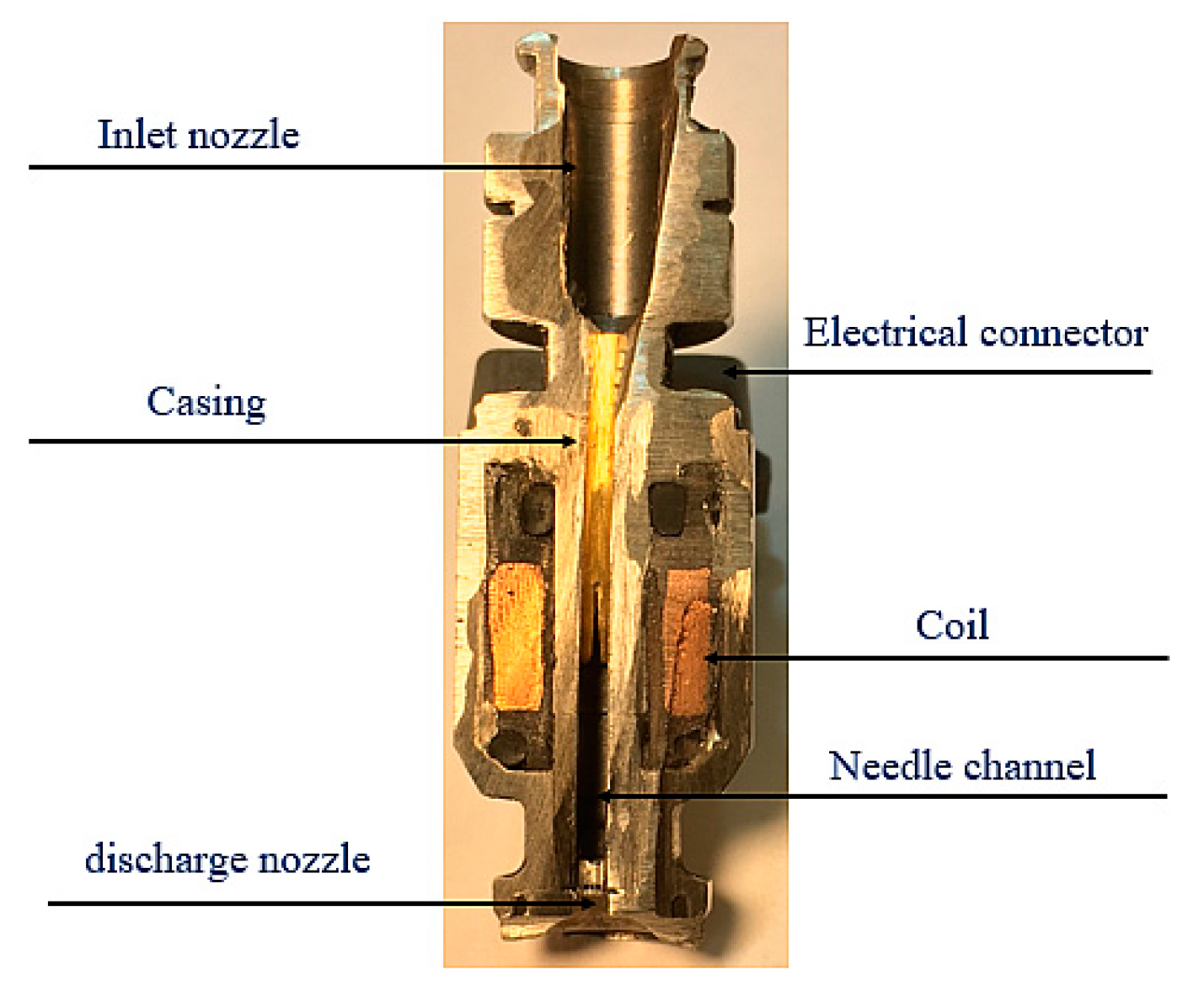
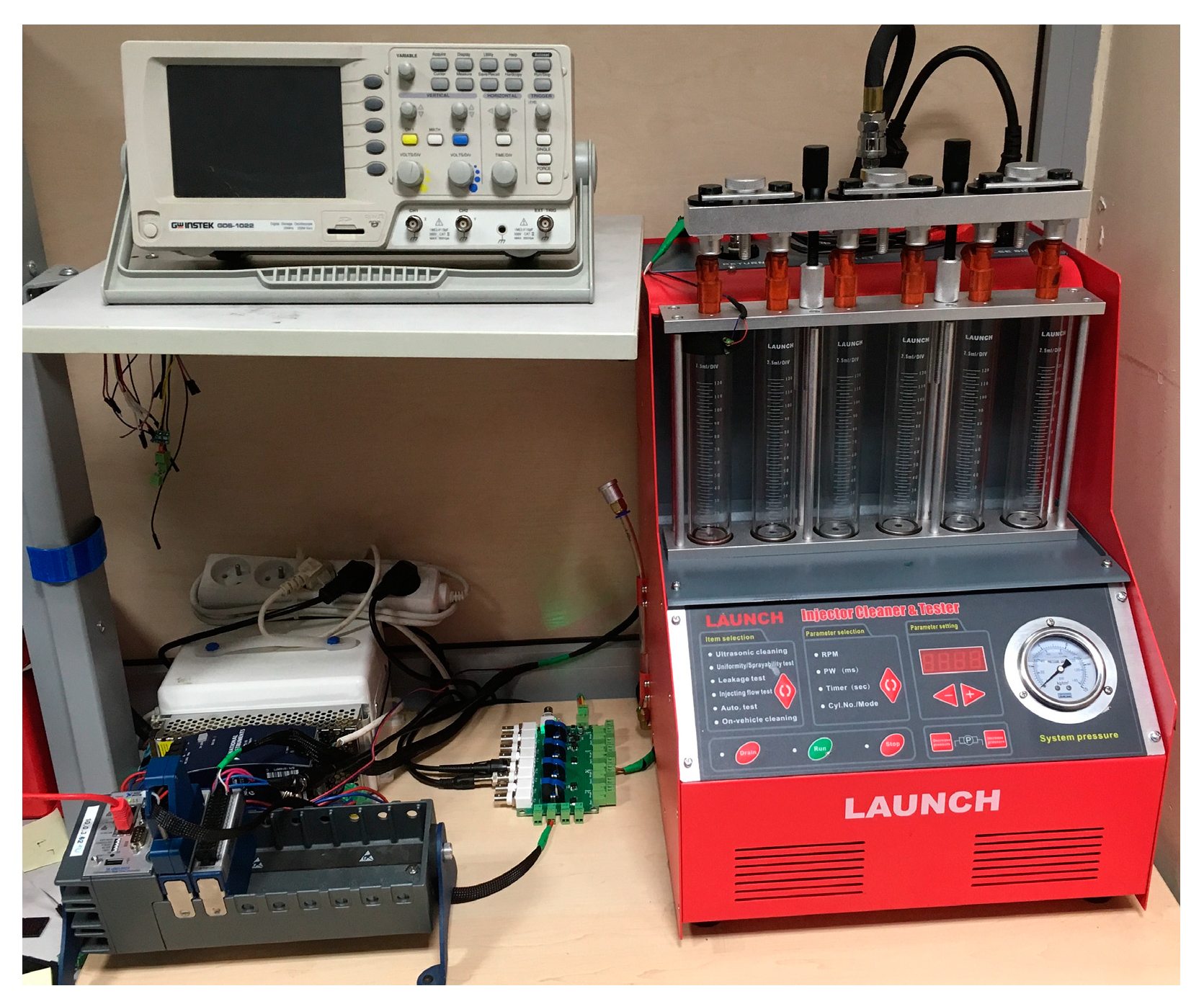
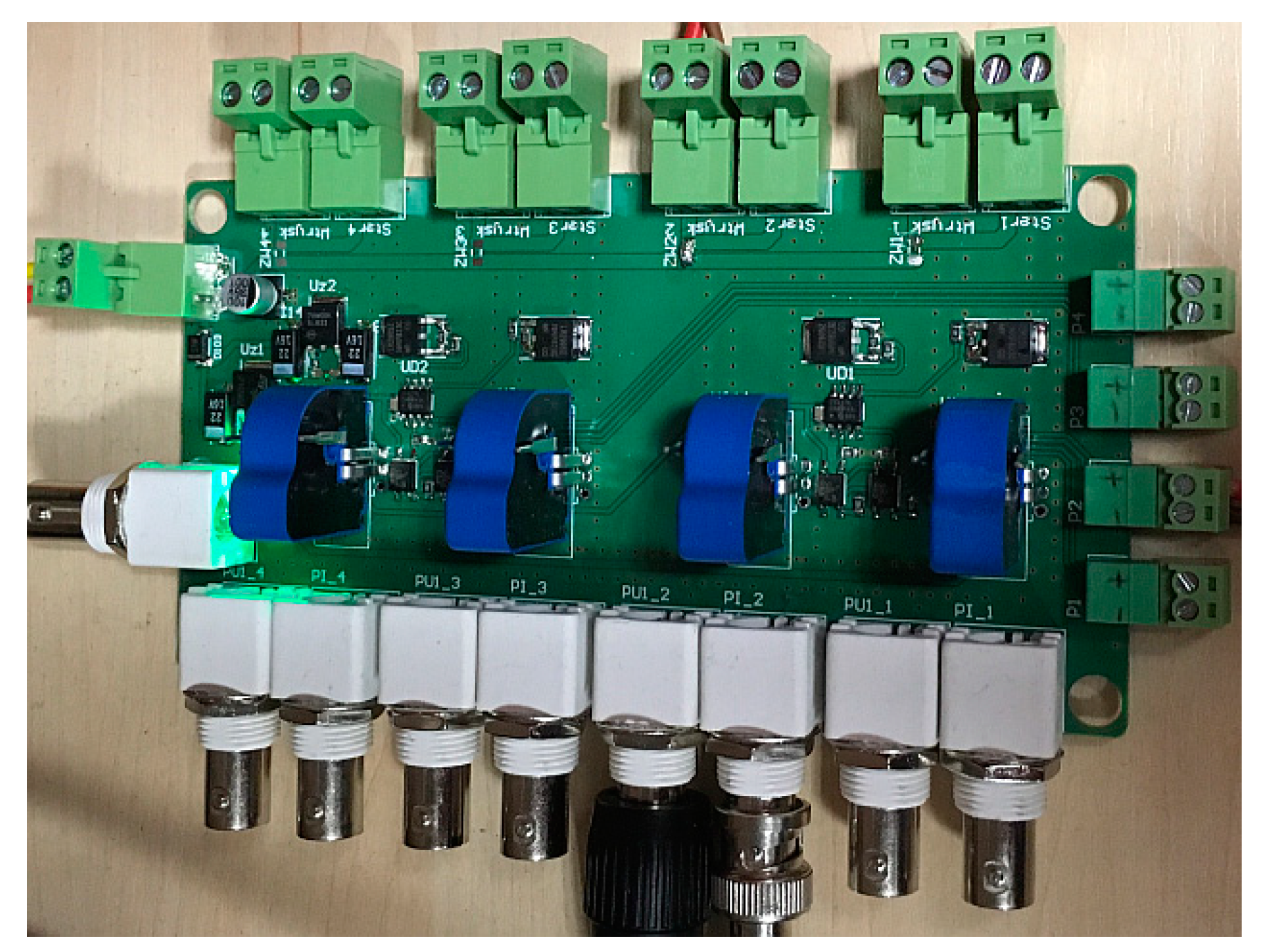


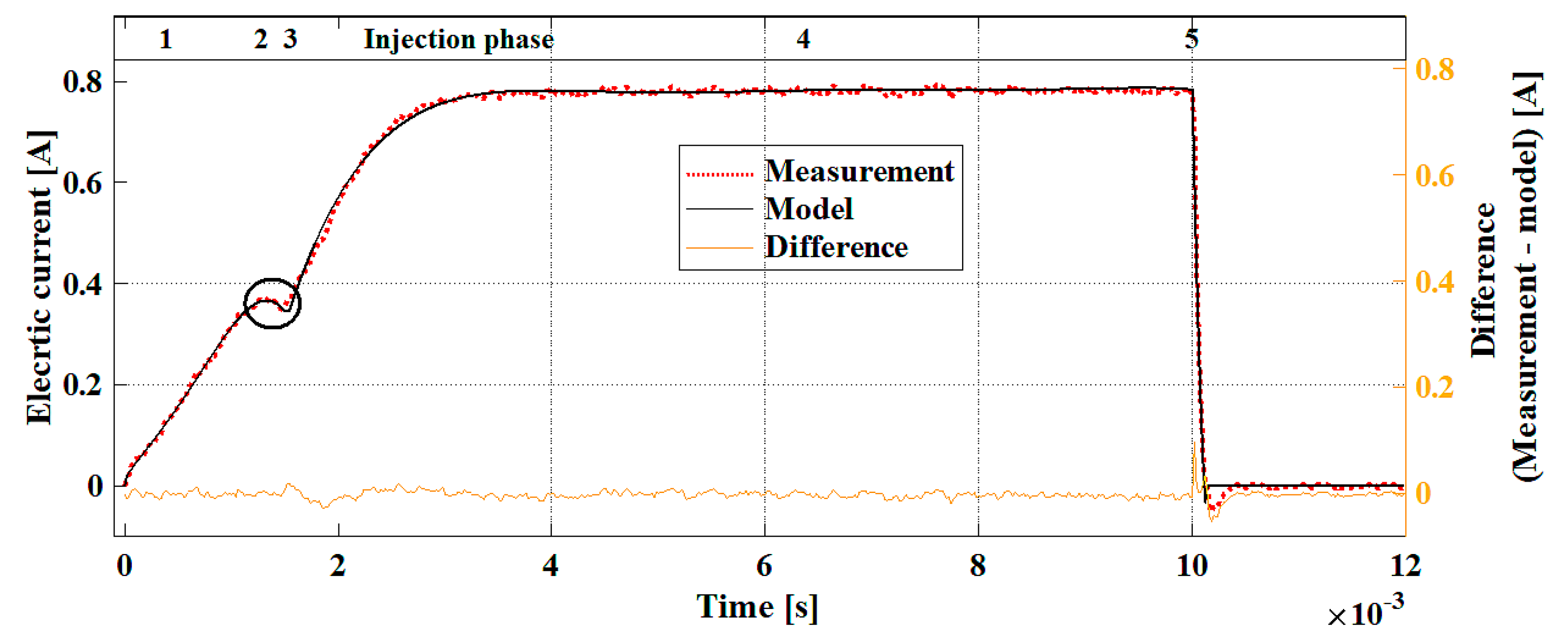

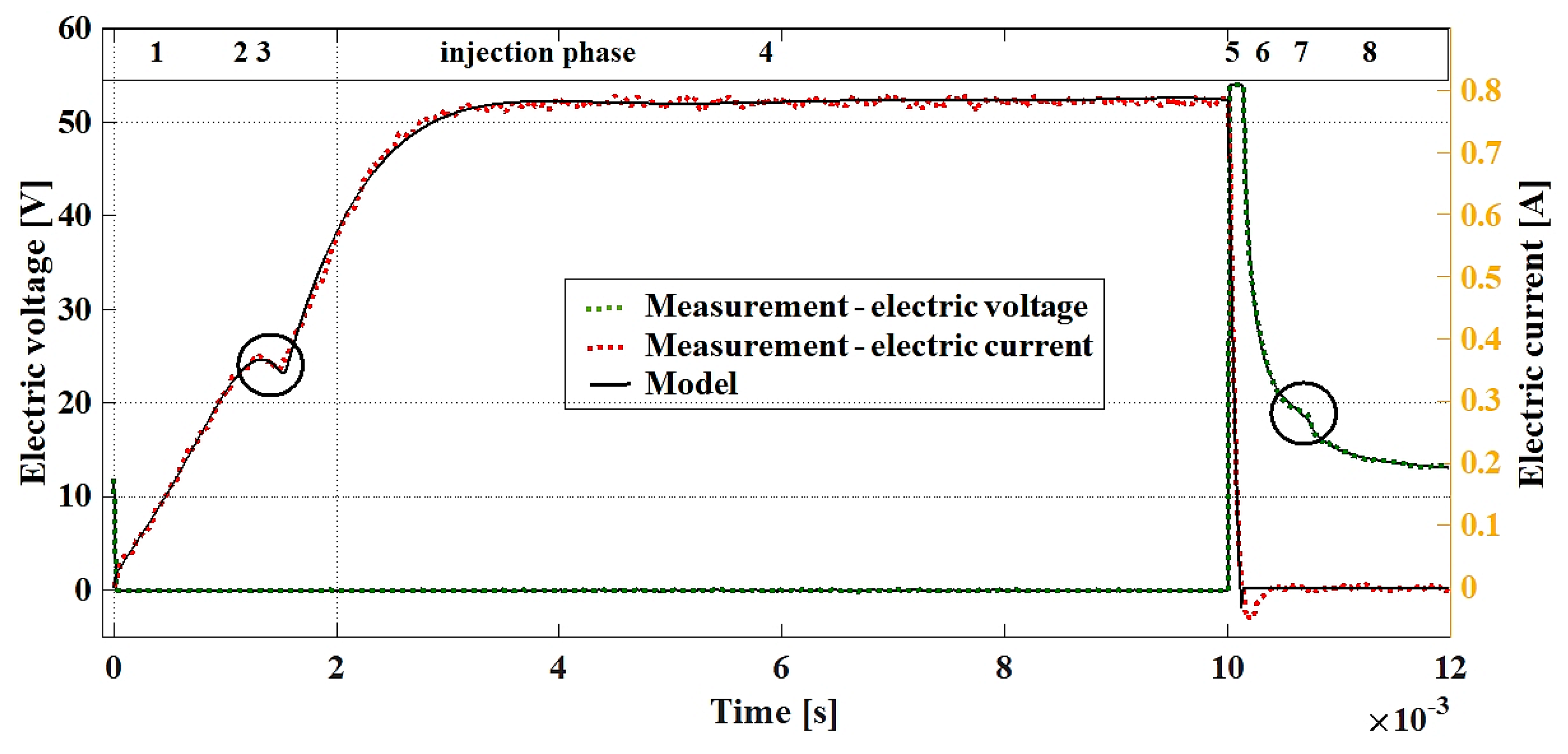
© 2020 by the authors. Licensee MDPI, Basel, Switzerland. This article is an open access article distributed under the terms and conditions of the Creative Commons Attribution (CC BY) license (http://creativecommons.org/licenses/by/4.0/).
Share and Cite
Więcławski, K.; Mączak, J.; Szczurowski, K. Electric Current Waveform of the Injector as a Source of Diagnostic Information. Sensors 2020, 20, 4151. https://doi.org/10.3390/s20154151
Więcławski K, Mączak J, Szczurowski K. Electric Current Waveform of the Injector as a Source of Diagnostic Information. Sensors. 2020; 20(15):4151. https://doi.org/10.3390/s20154151
Chicago/Turabian StyleWięcławski, Krzysztof, Jędrzej Mączak, and Krzysztof Szczurowski. 2020. "Electric Current Waveform of the Injector as a Source of Diagnostic Information" Sensors 20, no. 15: 4151. https://doi.org/10.3390/s20154151




